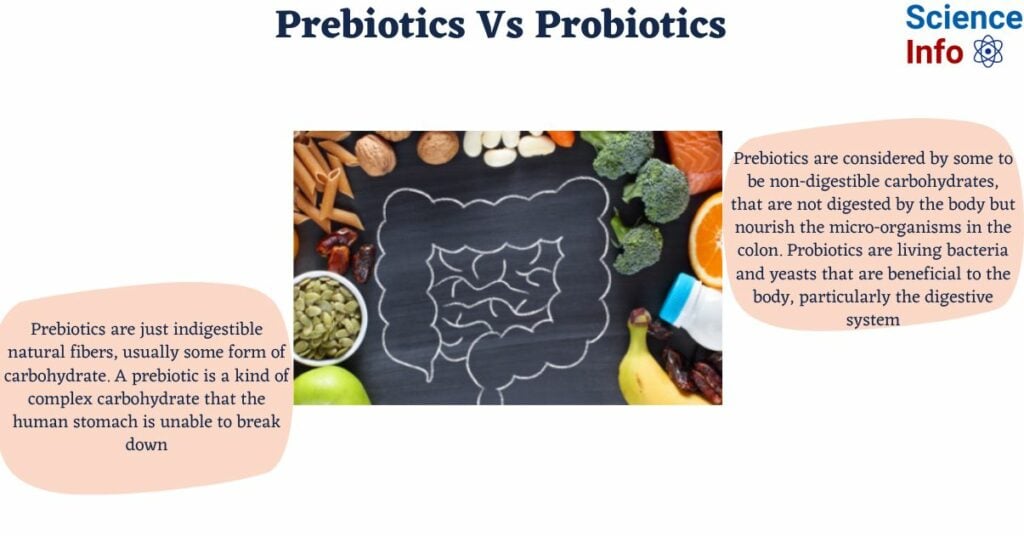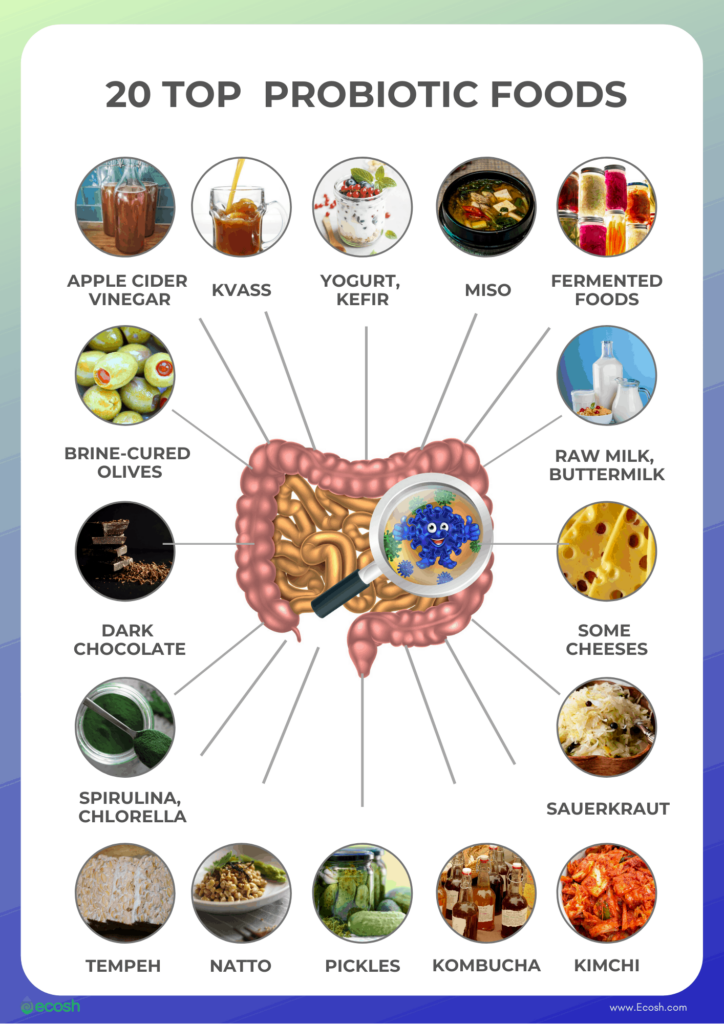Prebiotics and probiotics are two crucial nutrients for gut health that support the growth of beneficial gut flora. Since your gut health affects many other aspects of your overall health, eating foods that support it is crucial.

These days, it seems like everyone is discussing gut health, and with good cause. Over 60% of adults in the United States who participated in a recent poll with over 70,000 respondents reported having at least one gastrointestinal, or gut, problem in the previous week. Additionally, there is evidence to support the theory that gut dysbiosis, or an imbalance of “good” bacteria in the gut, might affect general health and cause symptoms related to the gut.
Understanding prebiotics and probiotics is crucial because, although they serve different purposes, they are both crucial for gut health.
Interesting Science Videos
What are Prebiotics?
Prebiotics are defined as “a substrate that is selectively utilized by host microorganisms conferring a health benefit” by official scientific definitions.
Prebiotics, however, are just indigestible natural fibers, usually some form of carbohydrate. These fibers have little to no calorific value since the human body is unable to break them down. The good bacteria that reside in our gut microbiome like feasting on prebiotic fibers, even if we are unable to digest them.
A prebiotic is a kind of complex carbohydrate that the human stomach is unable to break down. Therefore, prebiotics provide energy to our gut flora rather than to humans. Prebiotics specifically encourage the body’s beneficial (probiotic) microorganisms to proliferate. In addition to being naturally present in many plant foods including leeks, onions, garlic, bananas, Jerusalem artichokes, and others, they can also be taken as supplements.
The idea of prebiotics was initially presented by Glenn Gibson and Marcel Roberfroid in 1995.
Categorizing Prebiotics
To categorize a substance as a prebiotic, the following standards are applied: It should:
(i) be able to withstand the acidic pH of the stomach;
(ii) be fermented by the intestinal microbiota;
(iii) be incapable of being hydrolyzed by mammalian enzymes; and
(iv) be able to selectively stimulate the growth and/or activity of intestinal bacteria, all of which improve the health of the host.
Distinguishing Prebiotics from carbohydrates
Even though not all prebiotics are derived from carbs, one can use the following two criteria to separate prebiotics that are derived from carbohydrates from those that are not:
(i) Fibers are carbohydrates that have a degree of polymerization (DP) of three or more, and
(ii) they are incapable of being hydrolyzed by the small intestine’s natural enzymes.
Sources of Prebiotics
- Chicory Root: Contains inulin, a type of fiber that promotes the growth of beneficial bacteria.
- Dandelion Greens: Rich in fiber and antioxidants, supporting digestive health and feeding gut bacteria.
- Raw Leeks: High in inulin and FOS (fructooligosaccharides), aiding in gut health.
- Raw Garlic: Contains inulin and FOS, which serve as food for beneficial gut bacteria.
- Raw Jerusalem Artichoke: Extremely high in inulin, making it a potent prebiotic food.
- Raw or Cooked Onions: Provide inulin and FOS, supporting the growth of healthy gut bacteria.
- Raw Jicama: Contains inulin, promoting digestive health and beneficial gut bacteria.
- Raw Asparagus: A good source of inulin, which aids in maintaining a healthy gut flora.
- Under-ripe Bananas: Contain resistant starch, a type of prebiotic fiber beneficial for gut health.
- Yacon Syrup: High in FOS, making it a powerful prebiotic.
- Apples with Skin: Rich in pectin, a type of fiber that has prebiotic effects.
- Raw Honey: Contains oligosaccharides that have prebiotic benefits.
- Psyllium Husk: A type of fiber that promotes the growth of beneficial bacteria in the gut.
- Whole-Grain Wheat: Contains arabinoxylan oligosaccharides, which have prebiotic properties.
- Oatmeal: Rich in beta-glucan, a type of soluble fiber with prebiotic effects.

[Image source:https://www.nutrientsreview.com]
Benefits of Prebiotics
- It is advantageous to the immune system.
- It helps to avoid gastrointestinal issues in infants.
- It helps to treat dermatitis symptoms such skin inflammation.It helps to alter the gut environment.
- It reduces the risk of colorectal cancer.
- It reduces the risk of cardiovascular disease.
Side Effects of Prebiotics
The majority of prebiotics are safe to consume. If there are any negative effects, they are usually minimal and may include:
- Symptoms may include bloating, gas, or abdominal discomfort.
- These adverse effects often subside as your digestive system adjusts to the shift in intestinal environment.
What are Probiotics?
Prebiotics are considered by some to be non-digestible carbohydrates, that are not digested by the body but nourish the micro-organisms in the colon.
Probiotics are living bacteria and yeasts that are beneficial to the body, particularly the digestive system. We normally conceive of these as disease-causing microorganisms. However, your body is filled with germs, both beneficial and bad. Probiotics are sometimes referred to as “good” or “helpful” bacteria since they help maintain your gut healthy.
They occur naturally in the diet and can be found in foods including garlic, bananas, oats, onion, and leeks. Some scientists have criticized this theory for its weak definition, while others prefer to use the term’microbiota accessible carbohydrates’, which refers to fermentable dietary fiber that bacteria can consume. However, foods containing prebiotics are also part of a balanced diet and should be ingested on a regular basis.
Probiotics can help replace beneficial bacteria in your stomach, particularly if they have been interrupted by antibiotics, illness, or stress. Improved digestion, less diarrhea, and relief from certain gastrointestinal disorders such as irritable bowel syndrome (IBS) are among the potential advantages.
Probiotics refer to a wide range of microbes. They all have distinct benefits, but the majority fall into one of two categories.
- Lactobacillus: This may be the most widely used probiotic. It’s found in fermented foods like yogurt. Different strains can alleviate diarrhea and may benefit patients who are unable to digest lactose, the sugar found in milk.
- Bifidobacterium: Some dairy products include it. It may relieve the symptoms of irritable bowel syndrome (IBS) and other diseases.
- Saccharomyces boulardii: is a kind of yeast found in probiotics. It appears to alleviate diarrhea and other digestive issues.
Sources of Probiotics
- Yogurt: Fermented milk containing beneficial microorganisms, particularly Lactobacillus and Bifidobacterium.
- Kefir: A fermented milk drink containing a wide variety of probiotic bacteria and yeasts.
- Sauerkraut: Fermented cabbage with a high Lactobacillus content.
- Kimchi: A spicy Korean cuisine composed of fermented vegetables, especially cabbage and radishes, that contains Lactobacillus and other probiotics.
- Miso: A Japanese condiment created from fermenting soybeans with salt and koji (a type of fungus).
- Tempeh: A fermented soybean food containing helpful microorganisms.
- Cheese (particular varieties): Some aged cheeses, including Gouda, mozzarella, and cheddar, may contain beneficial bacteria.
- Kombucha: A fermented tea beverage with a symbiotic bacterium and yeast culture (SCOBY).
- Kvass: A classic Eastern European fermented drink prepared from rye bread or beets.
- Fermented soy sauce: Traditional soy sauce is produced by a fermentation process that involves fungi and bacteria.
- Sourdough bread: Made from dough that has spontaneously fermented with wild yeast and lactic acid bacteria
- Natto: A traditional Japanese dish prepared from fermented soybeans high in Bacillus subtilis.
- Pickles (naturally fermented): Cucumbers are fermented in a brine of water and salt to promote the growth of healthy microorganisms.
- Buttermilk (traditional): Probiotics are naturally present in the liquid left behind after churning butter.

[Image source: https://ecosh.com/]
Benefits of Probiotics
Diarrhea, particularly when associated with specific antibiotics. Probiotics may also aid with infectious diarrhea, particularly in youngsters.
Inflammatory bowel diseases (IBD) include Crohn’s disease and ulcerative colitis. Some probiotics may help keep ulcerative colitis in remission (a condition of little or no disease activity) and Crohn’s disease from relapsing and progressing.
Irritable Bowel Syndrome. Probiotics can occasionally alleviate symptoms such as stomach pain, bloating, gas, diarrhea, and constipation.
It is also found helpful in:
- Preventing and treating yeast infections
- Preventing and treating urinary tract infections.
- Lactose intolerance.
- Skin conditions like eczema
- Treating specific stomach and respiratory diseases, particularly in youngsters
- Treating allergies and asthma.
- Reducing inflammation, such as rheumatoid arthritis.
Side Effects of Probiotics
While there is less data on the safety of probiotics, they appear to be safe for healthy persons to consume. They have a long history of broad and frequent use among the general public. People with weakened immune systems face a slight risk of undesirable side effects. This includes persons using immunosuppressive medicines, people with serious conditions, and premature babies.
There is a possibility that a probiotic product may contain both beneficial and harmful microbes. Because microbes are so minute, the wrong sort can get in unnoticed if a product is not carefully checked. This is uncommon and poses no significant risk to the majority of people. A healthy immune system will quickly remove the imposter. However, in people with low immune systems, it could lead to a deadly illness.
Difference Between Prebiotics and Probiotics
Probiotics, prebiotics may appear to be synonyms, but a prefix might make all the difference. The first group consists of microorganisms that promote health. The latter two categories are composed of helpful chemicals. However, all three biotics are required to support the gut microbiome, which is a colony of microscopic organisms that live in the gastrointestinal system. With both beneficial and dangerous bacteria thriving in the human body, diet-related factors known as biotics assist tip the balance in the right direction. It is crucial to comprehend their differences.
| Prebiotics | Probiotics | |
| Definition | Prebiotics are just indigestible natural fibers, usually some form of carbohydrate. A prebiotic is a kind of complex carbohydrate that the human stomach is unable to break down. | Prebiotics are considered by some to be non-digestible carbohydrates, that are not digested by the body but nourish the micro-organisms in the colon. Probiotics are living bacteria and yeasts that are beneficial to the body, particularly the digestive system |
| Sources | Chicory root, dandelion greens, raw leeks, raw garlic, raw Jerusalem artichoke, raw or cooked onions, raw jicama, raw asparagus, under-ripe bananas, yacon syrup, apples with skin, raw honey, psyllium husk, whole-grain wheat, oatmeal | Yogurt, kefir, sauerkraut, kimchi, miso, tempeh, natto, pickles (naturally fermented), buttermilk (traditional), kombucha, kvass, fermented soy sauce, sourdough bread |
| Advantages | mproves digestive health, stimulates immunological function, improves mineral absorption, and relieves constipation and IBS. | Restores intestinal balance, prevents and cures diarrhea, boosts immunological health, may improve mental health, controls allergies and eczema |
| Functions | Feed and promote the development and activity of beneficial gut bacteria. | Introduce helpful microorganisms directly into the gut. |
| Side Effects | Increase in fermentation, leading to increased gas production, bloating or bowel movement | possibility of sepsis for immunocompromised patients, can cause temporary discomfort in the stomach in some people. |
Video on Difference Between Prebiotics and Probiotics
References
- Prebiotics, Probiotics, Synbiotics and Its Importance in the Management of Diseases DOI: 10.1007/978-3-030-42319-3_10 In book: Functional Foods and Nutraceuticals
- https://www.health.com/probiotic-vs-prebiotic-7567907
- https://www.herbalife.com/en-us/wellness-resources/articles/the-difference-between-prebiotics-and-probiotics
- https://www.webmd.com/digestive-disorders/what-are-probiotics
- https://www.bbcgoodfood.com/howto/guide/what-are-probiotics-and-what-do-they-do
- Davani-Davari D, Negahdaripour M, Karimzadeh I, Seifan M, Mohkam M, Masoumi SJ, Berenjian A, Ghasemi Y. Prebiotics: Definition, Types, Sources, Mechanisms, and Clinical Applications. Foods. 2019 Mar 9;8(3):92. doi: 10.3390/foods8030092. PMID: 30857316; PMCID: PMC6463098.
- https://www.optibacprobiotics.com/learning-lab/about/prebiotics/what-are-prebiotics
- https://mana.md/prebiotic-vs-probiotic/

